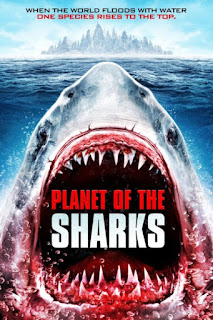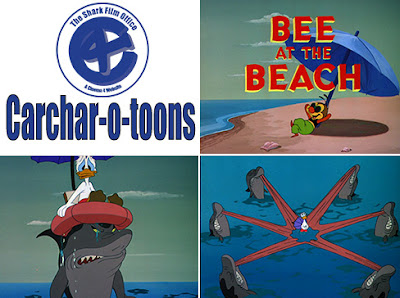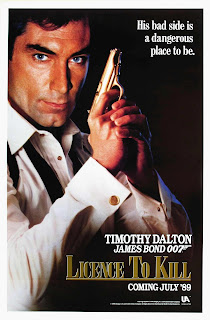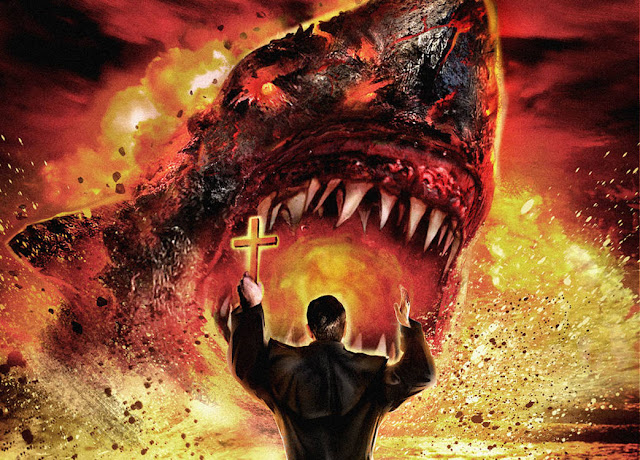Planet of the Sharks (2016)
 Planet of the Sharks (2016)
Planet of the Sharks (2016)Dir.: Mark Atkins
TC4P Rating: 4/9
Species: mutated great white with amplified telepathic abilities as Alpha leader of all sharks in the film; various non-mutated species of sharks, specifically hammerheads and bulls can be spotted.
The poster immediately to the right of this text speaks heavily of two influences. The first obvious influence, from even the swiftest sideways glance, is Jaws, which copies (though in a far more gruesome manner) the original film's image of the gaping maw of a monstrous shark rising up from the deep to swallow humanity whole. From the second influence – the title of the film itself, Planet of the Sharks – one can only surmise that someone has finally taken the logical leap in upping the renewed interest in the popular Planet of the Apes franchise, flooded the entire planet, and simply replaced the original concept's primates with sharks. I figured that such a thing might happen at some point along the way on our journey to total shark film awareness, and the fact that Planet of the Sharks hadn't already occurred in some form – at least, a good deal before we got to the idea of tornadoes chockfull of sharks – has been surprising to me in some small measure.
 |
| The first signifier that this film has "Planet of the" in the title... |
 And what we find in the shark-heavy future of this film is less Planet of the Apes than it is Waterworld, a film itself obviously heavily influenced by George Miller's Mad Max then-trilogy (with a little bit of Namor/Aquaman thrown into the mix). But there is no super-powered fish-man in the lead role here, though they do try to give us a variant on good ol' Max in the body of one Dillon Barrick, the captain of the Osprey. However, while he does have a noticeable accent, Barrick is not an Aussie like Max, but is embodied by the South African actor Brandon Auret, who is known in a cinematic sense mainly from small roles in all three of Neil Blomkamp's feature films (District 9, Elysium, and Chappie, in order of both chronological release and descending excellence). Barrick is appropriately scruffy and gruff, and barks orders somewhat unintelligibly when necessary. The problem with his character in Planet of the Sharks is that Barrick is neither mad like Max, nor is he overly heroic, merely content with being the right guy at the wrong place, but lets others handle a lot of the action most of the time. Or when he tries to be heroic, others – especially pesky, know-it-all scientist types – insist on doing it their way.
And what we find in the shark-heavy future of this film is less Planet of the Apes than it is Waterworld, a film itself obviously heavily influenced by George Miller's Mad Max then-trilogy (with a little bit of Namor/Aquaman thrown into the mix). But there is no super-powered fish-man in the lead role here, though they do try to give us a variant on good ol' Max in the body of one Dillon Barrick, the captain of the Osprey. However, while he does have a noticeable accent, Barrick is not an Aussie like Max, but is embodied by the South African actor Brandon Auret, who is known in a cinematic sense mainly from small roles in all three of Neil Blomkamp's feature films (District 9, Elysium, and Chappie, in order of both chronological release and descending excellence). Barrick is appropriately scruffy and gruff, and barks orders somewhat unintelligibly when necessary. The problem with his character in Planet of the Sharks is that Barrick is neither mad like Max, nor is he overly heroic, merely content with being the right guy at the wrong place, but lets others handle a lot of the action most of the time. Or when he tries to be heroic, others – especially pesky, know-it-all scientist types – insist on doing it their way.Planet of the Sharks has a focus problem. In fact, it has several focus problems. It wants to give us a hero, but splits its heroics up between too wide a cast of people. It wants us to think other characters are really important to its story, but they really are just extra baggage and/or fodder for the film's villains. It wants to tell to tell that hundreds of people live in particular places but never come close to convincing us that more than a handful do. It wants to take on an epic adventure the size of an entire planet, but only has the budget to center on a small area in the middle of an ocean. But, its most major problem is in its very premise. It wants to be Planet of the Apes, only with sharks. It wants to be Waterworld, only with sharks. It wants to be Max Max 2: The Road Warrior, only with sharks. But Planet of the Sharks fails itself because it really doesn't deliver on the one area that its title promises: sharks.
 |
| Good ol' Sparklenose! |
 |
| Bea... what is she good for? Absolutely nothin'... |
 |
| "I weeellll keeellll him!!!" |
 |
| Count yourself lucky, shark! She could have acted you to death... |
 |
| Oh, snap! |
 |
| Dr. Caroline Munro (Christia Visser), scientist/welder. |
 |
| "Hey! Are we all great whites in this shot?" |
 |
| Just hammers in this shot... |
 |
| Probably not something you want to see on your Pokemon Go! app... |
 |
| Man, sharks are getting so good at this breaching thing. Just like people in the Olympics... |
Besides, there were far dumber films shown during Sharknado Week, including ones with Sharknado right in the title. So, Planet of A Shark... and a Few Extra Sharks on the Side, has that going for it as well...
 |
| A little Christia Visser for the trip home... |



Comments